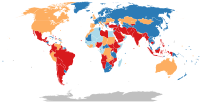
Photo from wikipedia
Three years since the COVID-19 pandemic started, there is still little information about patients with chronic medical conditions, such as cardiovascular diseases (CVDs), who become infected with SARS-CoV-2. A retrospective… Click to show full abstract
Three years since the COVID-19 pandemic started, there is still little information about patients with chronic medical conditions, such as cardiovascular diseases (CVDs), who become infected with SARS-CoV-2. A retrospective analysis was performed to evaluate the impact of the COVID-19 pandemic on patients with cardiovascular comorbidities hospitalized with positive RT-PCR results for SARS-CoV-2 during the highest peaks of the first three pandemic waves: April 2020, October 2020, and November 2021. The primary outcome was in-hospital mortality; the secondary outcomes were length of hospitalization and required mechanical ventilation to assess the disease severity. Data were extracted from the hospital electronic database system: 680 eligible cases were identified out of 2919 patients. Mortality was the highest in wave 3 (31.9%) compared to the previous waves (13.6% and 25.8%). Hospitalization was also significantly longer in wave 3 (11.58 ± 5.34 vs. 8.94 ± 4.74 and 10.19 ± 5.06; p < 0.001), and so was the need for mechanical ventilation (21.7% vs. 8.2% and 9%; p < 0.001). Older age and male gender were confirmed as highly significant predictors of unfavorable outcomes. Ischemic heart disease worsened the odds of patients’ survival irrespective of the three pandemic waves (Breslow–Day test, p = 0.387), with a marginally significant Mantel–Haenszel common estimate for risk: OR = 1.604, 95% (0.996; 2.586). The significantly worse outcomes in wave 3 could have been influenced by a combination of factors: the low percentage of vaccinations in Romanian population, the more virulent delta strain, and pandemic attrition in the care provided to these patients with chronic CVDs.
Journal Title: Healthcare
Year Published: 2023
Link to full text (if available)
Share on Social Media: Sign Up to like & get
recommendations!